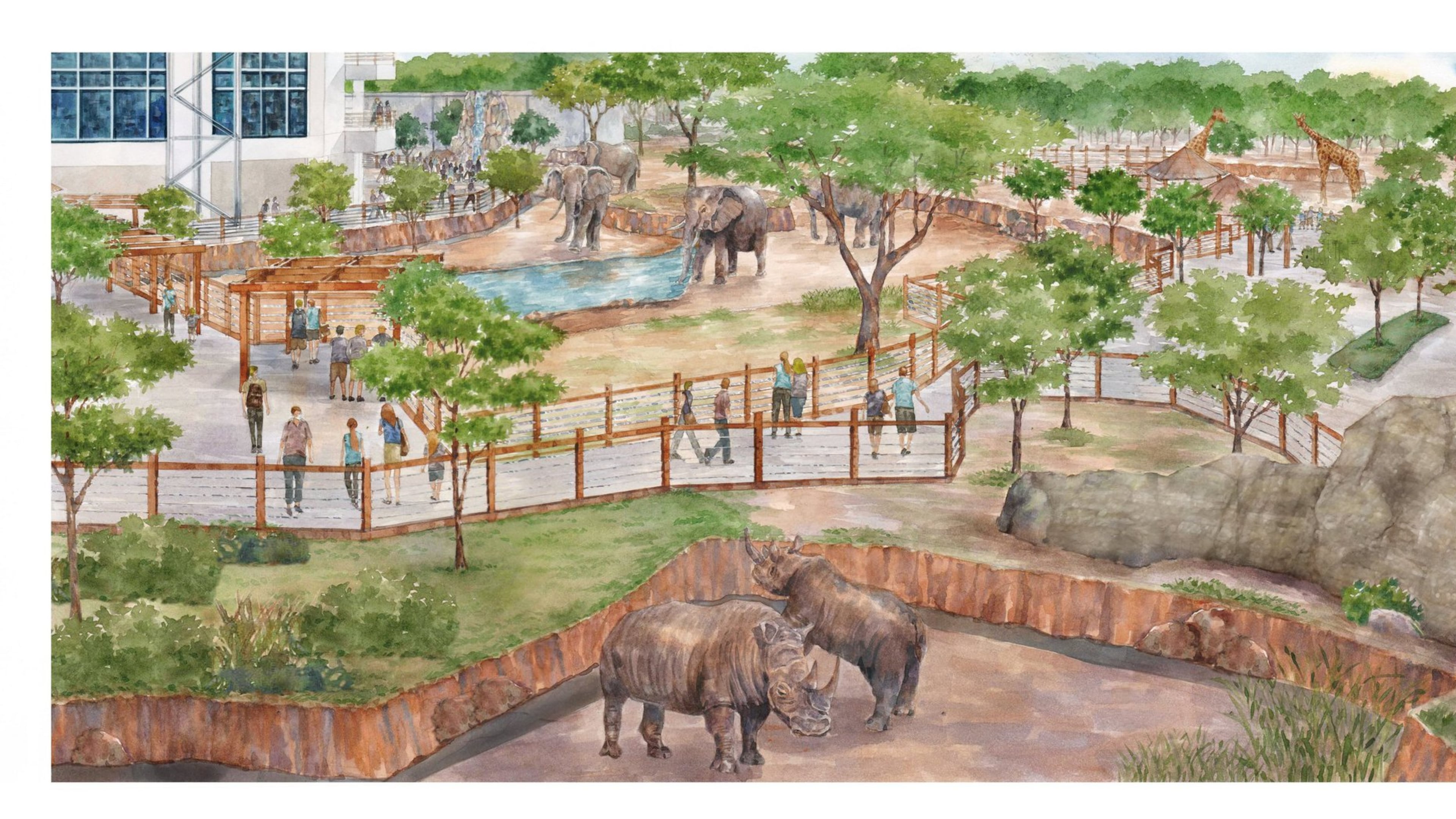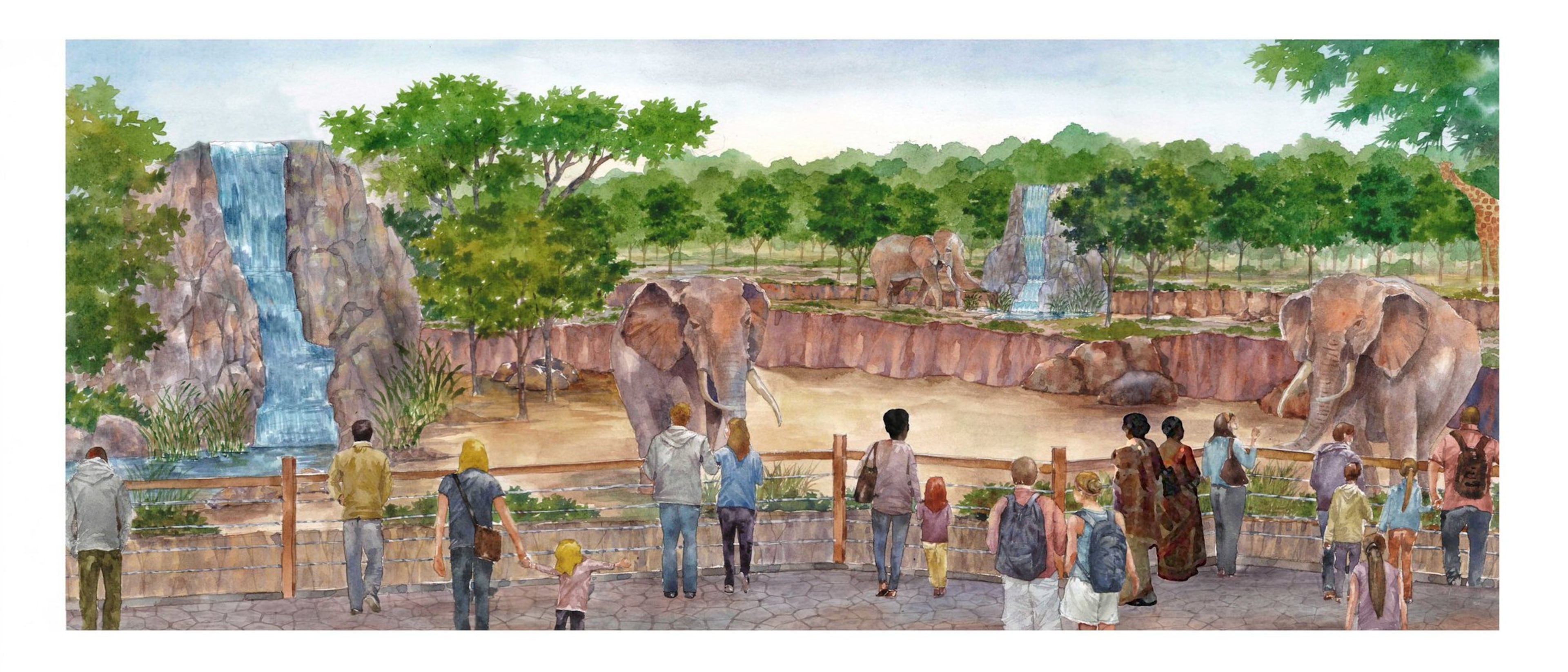Zoo Atlanta’s expansion brings African Savanna to Atlanta

On a recent sunny Monday, there was growling down at Zoo Atlanta, but it did not come from Hondo or his two brothers, the young African lions relaxing in the sun.
It was, instead, the sound of bulldozers and front-end loaders, moving dirt and hauling girders, as they dig under and around the old Cyclorama building.
The construction at that building, soon to become a new event facility and administrative office, is part of a $50 million expansion that is the most ambitious project since the zoo was transformed in the 1980s from a national embarrassment to a national exemplar.
This week, the zoo revealed more details of that project, along with some artist’s renderings showing an enormously expanded African Savanna exhibit and a new entry plaza.
The expansion will add almost 5 acres to the zoo’s 40-acre footprint, most of it around the Cyclorama building, which will be renamed Savanna Hall.
The renaming is not in honor of the city Savannah, but in reference to the differently spelled “savanna” grasslands of Africa, where the wild elephants roam. The 57,724-square-foot Savanna Hall will look out on the African Savanna exhibit, where the zoo’s two elephants will have much more roaming room, enough for four more pachyderms, plus giraffes and zebras.
Savanna Hall itself will be transformed from its days as the home of the cyclorama painting, “The Battle of Atlanta.” The interior has been gutted, and will be replaced with three floors that will house administrative offices, a catering kitchen, event facilities, a ballroom and balconies that look out on the wildlife below.
The proposed relocation of that enormous, 371-by-49-foot panoramic painting, back in 2014, was the event that triggered a cascade of changes, both at Zoo Atlanta and at the Atlanta History Center. A major gift that year made it possible for the History Center to construct a new cylindrical building to conserve and house the painting on its Buckhead campus.
>> RELATED: Cyclorama to make big move to Atlanta History Center
The planned relocation of the painting suddenly gave the modest-sized zoo more elbow room. It resulted in Grant Park's historic 1921 Cyclorama structure, and the nearly 5 acres surrounding it, being conveyed to the zoo. With room for administrative space in the reborn Savanna Hall, the zoo realized it could demolish its current administration building, which sits in the middle of what will become an entrance plaza.
>> RELATED: Zoo will grow when Cyclorama leaves Grant Park

That provides a solution to what has been a bit of an eyesore at the zoo. The first thing that visitors see, walking from the Cherokee Avenue parking lot, is the administration building, making the approach to the zoo a problematic experience.
“People can’t tell where the entrance to the zoo is,” said Raymond B. King, president and CEO of Zoo Atlanta, sitting beneath a portrait of a gorilla in his soon-to-be demolished office. “They knock on the window asking how to get there.”
That bottleneck will be replaced with an open plaza, pathways, benches, a fountain and trees that will be part of what the zoo is calling a Grand New View.

Workers broke ground last fall at Savanna Hall and the African Savanna exhibit. The exhibit should open in the summer of 2019, and the new plaza and refurbished Savanna Hall should both be ready in the spring of 2020, King said. A fund drive more than met the estimated $38 million cost of the changes, but those costs have gone up.
>> RELATED: Zoo's facelift will cost money: Atlanta is pitching in
King said replacing the foundation of the 1921 Cyclorama structure added unforeseen bills, as did new tariffs on steel, driving the cost of the project to $50 million. The overage was covered by the zoo’s donors and tax credits for preserving the historic structure.
At the zoo, one can see crews carefully handing steel I-beams through a hole in the wall of the old Cyclorama building, like a reverse game of Jenga.
“It would have been easier to build a new building,” said King, but the historic value of the Cyclorama building was compelling. Also, the neighborhood would have been sad to see it go. “We will celebrate the history of the building, inside the building.”
The African Savanna exhibit will provide three times as much room for elephants, meaning that Zoo Atlanta will be able to house bulls (which must be cared for separately) as well as cows. With the approval of the Association of Zoos & Aquariums and its Species Survival Plan, that would mean that the zoo could begin a breeding program. It could, at the least, increase the herd and provide more interaction for these very social animals.
In the area freed up by the elephants, the zoo plans a habitat for white rhinoceros.
Other changes are on the horizon. The city of Atlanta is building an underground parking deck in the part of Grant Park adjacent to the zoo, which will solve some of the zoo’s parking issues. A state-of-the-art barn for the elephants is also under construction.
Despite a few surprises, King said he’s confident in the construction timeline, and is already booking events at the hall for April 2020.
ZOO ATLANTA’S EXPANSION
The Grand New View:
• African Savanna exhibit: to be completed by summer 2019, tripling the size of the current elephant habitat
• Savanna Hall (event facility/administrative offices), 57,724 square feet: to be completed by spring 2020
• Added acreage: 4.87
• Cost: $50 million
You can view progress and a conceptual video at zooatlanta.org/grand_new_view.


